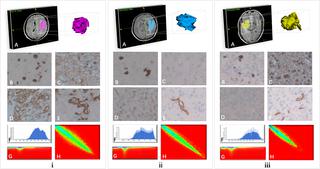Our official English website, www.x-mol.net, welcomes your feedback! (Note: you will need to create a separate account there.)
High-order radiomics features based on T2 FLAIR MRI predict multiple glioma immunohistochemical features: A more precise and personalized gliomas management.
PLOS ONE ( IF 3.7 ) Pub Date : 2020-01-22 , DOI: 10.1371/journal.pone.0227703 Jing Li 1, 2 , Siyun Liu 3 , Ying Qin 3 , Yan Zhang 1 , Ning Wang 1 , Huaijun Liu 1
PLOS ONE ( IF 3.7 ) Pub Date : 2020-01-22 , DOI: 10.1371/journal.pone.0227703 Jing Li 1, 2 , Siyun Liu 3 , Ying Qin 3 , Yan Zhang 1 , Ning Wang 1 , Huaijun Liu 1
Affiliation

|
OBJECTIVE
To investigate the performance of high-order radiomics features and models based on T2-weighted fluid-attenuated inversion recovery (T2 FLAIR) in predicting the immunohistochemical biomarkers of glioma, in order to execute a non-invasive, more precise and personalized glioma disease management.
METHODS
51 pathologically confirmed gliomas patients committed in our hospital from March 2015 to June 2018 were retrospective analysis, and Ki-67, vimentin, S-100 and CD34 immunohistochemical data were collected. The volumes of interest (VOIs) were manually sketched and the radiomics features were extracted. Feature reduction was performed by ANOVA+ Mann-Whiney, spearman correlation analysis, least absolute shrinkage and selection operator (LASSO) and Gradient descent algorithm (GBDT). SMOTE technique was used to solve the data bias between two groups. Comprehensive binary logistic regression models were established. Area under the ROC curves (AUC), sensitivity, specificity and accuracy were used to evaluate the predict performance of models. Models reliability were decided according to the standard net benefit of the decision curves.
RESULTS
Four clusters of significant features were screened out and four predicting models were constructed. AUC of Ki-67, S-100, vimentin and CD34 models were 0.713, 0.923, 0.854 and 0.745, respectively. The sensitivities were 0.692, 0.893, 0.875 and 0.556, respectively. The specificities were: 0.667, 0.905, 0.722, and 0.875, with accuracy of 0.660, 0.898, 0.738, and 0.667, respectively. According to the decision curves, the Ki-67, S-100 and vimentin models had reference values.
CONCLUSION
The radiomics features based on T2 FLAIR can potentially predict the Ki-67, S-100, vimentin and CD34 expression. Radiomics model were expected to be a computer-intelligent, non-invasive, accurate and personalized management method for gliomas.
中文翻译:

基于T2 FLAIR MRI的高阶放射学特征可预测多种神经胶质瘤的免疫组织化学特征:更精确和个性化的神经胶质瘤管理。
目的探讨基于T2加权液体衰减倒置恢复(T2 FLAIR)的高阶放射学特征和模型在预测神经胶质瘤免疫组织化学生物标志物中的性能,以执行非侵入性,更精确和个性化的神经胶质瘤疾病管理。方法回顾性分析我院2015年3月至2018年6月经病理证实的51例脑胶质瘤患者的临床资料,收集Ki-67,波形蛋白,S-100和CD34免疫组化数据。手动绘制感兴趣的体积(VOI)并提取放射学特征。通过ANOVA + Mann-Whiney,spearman相关分析,最小绝对收缩和选择算子(LASSO)和梯度下降算法(GBDT)进行特征缩减。SMOTE技术用于解决两组之间的数据偏差。建立了全面的二元逻辑回归模型。ROC曲线下的面积(AUC),敏感性,特异性和准确性用于评估模型的预测性能。根据决策曲线的标准净收益确定模型的可靠性。结果筛选出四个具有重要特征的簇,并构建了四个预测模型。Ki-67,S-100,波形蛋白和CD34模型的AUC分别为0.713、0.923、0.854和0.745。灵敏度分别为0.692、0.893、0.875和0.556。特异性为:0.667、0.905、0.722和0.875,准确度分别为0.660、0.898、0.738和0.667。根据决策曲线,Ki-67,S-100和波形蛋白模型具有参考值。结论基于T2 FLAIR的放射学特征可以潜在地预测Ki-67,S-100,波形蛋白和CD34的表达。放射线学模型有望成为一种计算机智能,无创,准确且个性化的神经胶质瘤治疗方法。
更新日期:2020-01-23
中文翻译:

基于T2 FLAIR MRI的高阶放射学特征可预测多种神经胶质瘤的免疫组织化学特征:更精确和个性化的神经胶质瘤管理。
目的探讨基于T2加权液体衰减倒置恢复(T2 FLAIR)的高阶放射学特征和模型在预测神经胶质瘤免疫组织化学生物标志物中的性能,以执行非侵入性,更精确和个性化的神经胶质瘤疾病管理。方法回顾性分析我院2015年3月至2018年6月经病理证实的51例脑胶质瘤患者的临床资料,收集Ki-67,波形蛋白,S-100和CD34免疫组化数据。手动绘制感兴趣的体积(VOI)并提取放射学特征。通过ANOVA + Mann-Whiney,spearman相关分析,最小绝对收缩和选择算子(LASSO)和梯度下降算法(GBDT)进行特征缩减。SMOTE技术用于解决两组之间的数据偏差。建立了全面的二元逻辑回归模型。ROC曲线下的面积(AUC),敏感性,特异性和准确性用于评估模型的预测性能。根据决策曲线的标准净收益确定模型的可靠性。结果筛选出四个具有重要特征的簇,并构建了四个预测模型。Ki-67,S-100,波形蛋白和CD34模型的AUC分别为0.713、0.923、0.854和0.745。灵敏度分别为0.692、0.893、0.875和0.556。特异性为:0.667、0.905、0.722和0.875,准确度分别为0.660、0.898、0.738和0.667。根据决策曲线,Ki-67,S-100和波形蛋白模型具有参考值。结论基于T2 FLAIR的放射学特征可以潜在地预测Ki-67,S-100,波形蛋白和CD34的表达。放射线学模型有望成为一种计算机智能,无创,准确且个性化的神经胶质瘤治疗方法。


























 京公网安备 11010802027423号
京公网安备 11010802027423号